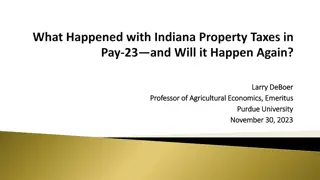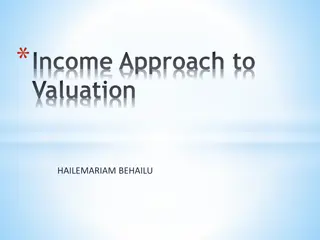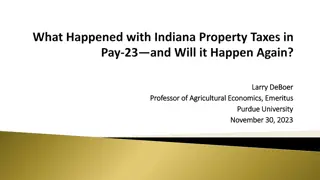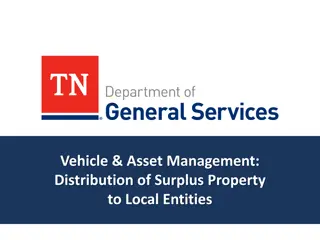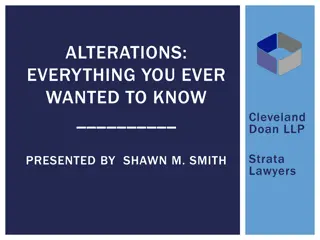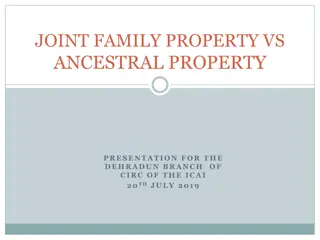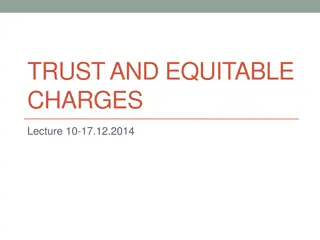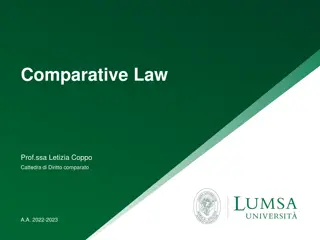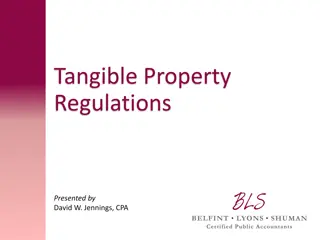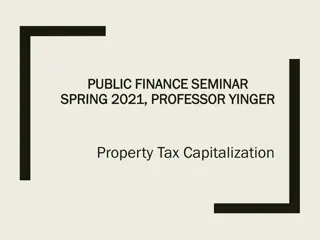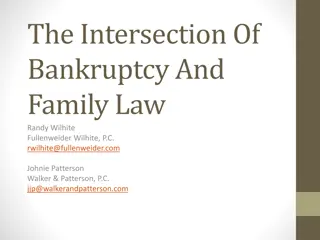Understanding Servitude in Property Law
Servitude in property law involves a property right where the owner of one plot of land can use another land for specific purposes. The purpose of servitude is to allow the owner of the dominant tenement to benefit from another's land while respecting limitations and restrictions set by the law. Servitudes can be created through contracts, wills, or acquisitive prescription, with the aim of ensuring fair usage and balance between the dominant and servient tenements.
Download Presentation

Please find below an Image/Link to download the presentation.
The content on the website is provided AS IS for your information and personal use only. It may not be sold, licensed, or shared on other websites without obtaining consent from the author. Download presentation by click this link. If you encounter any issues during the download, it is possible that the publisher has removed the file from their server.
E N D
Presentation Transcript
Prepared by: Mohamed wali Isse Ahmed Lecturer in Law 2016
Chapter 6 Servitude Concept of Servitude Servitude is a property right vested in the owner, called dominant tenement, of one plot of land to use a land belonging to another which is called servient tenement for certain purposes. The right of servitude may only be created for the benefit of another land. servitude shall not create an obligation to perform positive acts on the owner of the servient tenement the lands are not required to be adjacent always but some jurisdictions require to be adjacent like France and Germany.
Purpose of servitude The main purpose of servitude is: To enable the owner of the dominant tenement to derive the best possible use and benefit from his land by giving him certain rights on the land belonging to another person, called servient owner. In order, not to misuse of this right, there are some restrictions that the law puts on servitude right which are the following: 1. Servitude should be used exclusively for the purpose of using or exploiting the dominant land and it must be used exclusively for that purpose.
2. The law also limits the rights of the owner of the dominant tenement to use the servient tenement only to purposes for which the servitude was created. 3. The owner of the servient tenement has the right to redeem the servitude where the benefits or advantages it provides to the dominant tenement are lesser than the inconveniences or damages it causes to the servient tenement. 4. The owner of the servient tenement cannot be required to do positive acts; he may merely be required to abstain from doing something or to permit the owner of the dominant land to do something on the servient land.
Sources of Servitude The right of servitude may arise from a contract, a will, acquisitive prescription or the provisions of the law. 1. A servitude may be created by an agreement or contract concluded between the owner of the dominant tenement and the owner of the servient tenement. 2. Servitude may also arise from the will and inheritance. 3. By Acquisitive Prescription: servitude may arise from enjoyment of the servient tenement for a period of ten years; this mode of acquisitive prescription applies only to apparent servitude.
An apparent servitude is a servitude that requires certain external and visible or apparent structures or means for its enjoyment or exercise, which also evidence its existence. 4. Servitude arising out of the provisions of the law. The contiguity of land belonging to different owners or occupied by different persons creates conflict if either or both of them wish to enjoy their lands without any consideration for the damages or annoyance caused to the other.
Types of Servitude a. Urban servitudes and rural servitudes Urban servitudes are servitudes created and enjoyed in urban areas. They include right of view, the right to install water, gas or electrical lines. Rural or servitudes are those types of servitudes created and enjoyed in rural areas such as right of way or right to cross a parcel of land on foot. b. Continuous and discontinuous servitudes: A continuous servitude is a servitude that continues without continuous human intervention. For example, Servitudes of view and drawing water are considered as continuous servitudes.
A discontinuous servitude is a servitude that cannot exist without a continuous human intervention. Servitudes of way or passage, pasturing cattle and servitude of extracting quarry are examples of discontinuous servitude. This classification is based on whether or not the right of servitude can continue without continuous human intervention.
c. Apparent and non-apparent servitudes: Apparent servitudes are servitudes that are manifested by external works such as ditches, pipelines or a bridge, roads (means of enjoyment). Non-apparent Servitudes are, on the other hand, servitudes whose existences are not manifested by external works necessary for their enjoyment by the owner of the dominant tenement. Servitudes of pasturing animals, cutting wood are examples of non- apparent servitude.
d. Positive and negative Servitude: Servitude is considered positive where it entitles the owner of the dominant tenement to use the servient tenement for a specified purpose. Servitude of way, extracting quarry, drawing water are examples of this type of servitude. Servitude is considered a negative where it imposes on the owner of the servient tenement the obligation to refrain from doing certain activities on his land, for example, from erecting certain kinds of buildings or planting trees.
Rights and duties of the parties The owner of the servient tenement shall have the following rights and duties: 1. The owner of the servient tenement shall have the obligation to allow the owner of the dominant tenement to use his land for the purpose for which the servitude is created and refrain from exercising certain rights such as the right to prevent other persons from entering his land or using his land.
2. He also has the obligation to perform works related to the construction, maintenance and repair of the means necessary for the exercise of rights of servitude by the owner of the dominant tenement, where he has undertaken such obligation under the instrument creating the servitude. 3. The owner of the servient tenement has the right to redeem the servitude where he can prove that the damages or inconveniences caused by the servitude are way higher than the benefits or advantages derived by the owner of the dominant tenement.
3. The owner of the servient tenement may require that the servitude be exercised on such other part of the servient tenement as will be equally convenient to the owner of the dominant tenement. The owner of the dominant tenement shall have the following rights and duties: 1. The owner of the dominant tenement must exercise his rights in a manner which causes minimum inconvenience or damage to the servient tenement. 2. Where the dominant tenement is divided, the right of servitude shall continue for the benefit of the owners of each parcel of land.
3. Where the servient tenement is divided, the owner of the dominant tenement shall have the right of servitude on each of the new parcels of land. Extinction of Servitude Right of servitude shall be extinguished for any one of the following reasons: 1. Release by the owner of dominant tenement. 2. Redemption of the servitude by the owner of the servient tenement. 3. Surrender of the servient tenement to the owner of the dominant tenement where he is not capable of doing an obligation rose out from the contract like performing positive works such construction, repairing and maintenance.
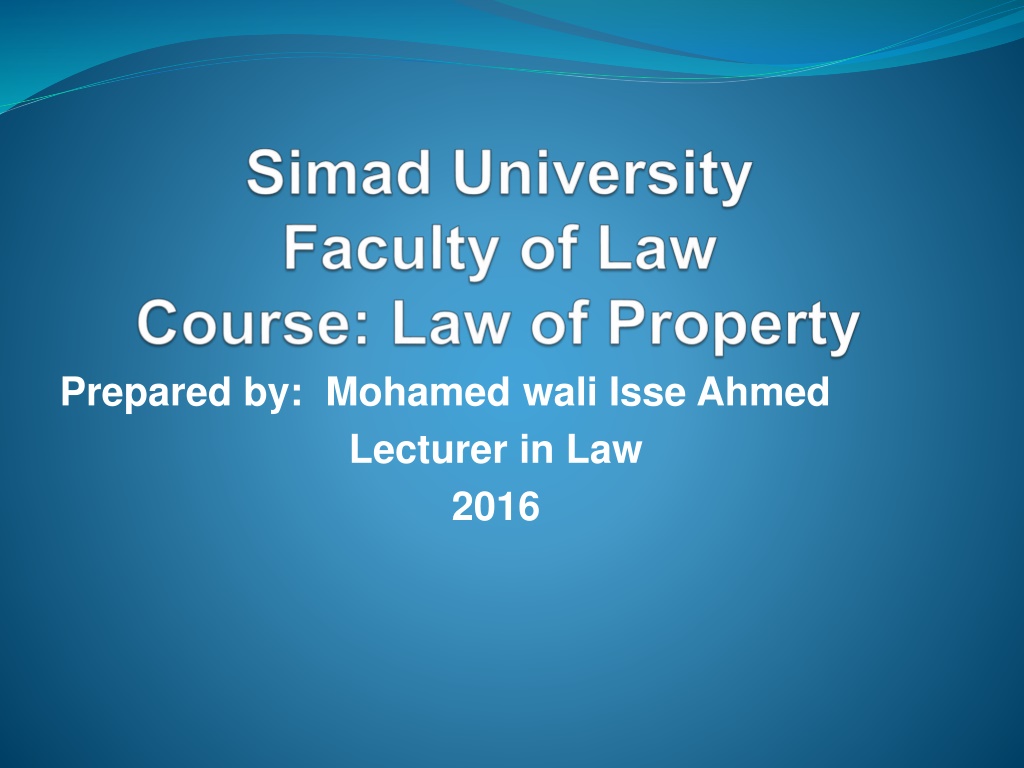


![Property Settlements in Family Law: Case Study of Stamatou & Stamatou [2022] FedCFamC1F 241](/thumb/63303/property-settlements-in-family-law-case-study-of-stamatou-stamatou-2022-fedcfamc1f-241.jpg)
